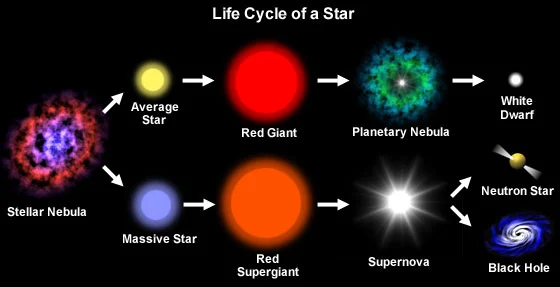The Complete Life Cycle of Stars: From Formation to Death

Stars, the celestial luminaries that dot the night sky, undergo a mesmerizing journey from their inception to their eventual demise. Understanding the complete life cycle of stars not only unveils the intricacies of astrophysical processes but also offers a glimpse into the profound interconnectedness of cosmic phenomena.
Stellar Nebula:
The journey of a star begins amidst the vast expanses of interstellar space, where giant clouds of gas and dust, known as stellar nebulae, serve as cosmic cradles for star formation. Under the relentless pull of gravity, these molecular clouds collapse, giving birth to protostars – embryonic stellar entities shrouded in swirling cocoons of dust and gas.
Formation of Stars:
As gravitational forces continue to accumulate matter, the core of the protostar grows denser and hotter until nuclear fusion ignites, marking the birth of a star. Depending on the mass of the protostar, it may evolve into an average star, like our Sun, or a massive star with significantly more mass.
Main Sequence:
Stars like our Sun spend the majority of their lives in the main sequence phase – a period of stable hydrogen fusion in their cores. The luminosity and temperature of a star on the main sequence are determined by its mass, with more massive stars burning hotter and brighter than their low-mass counterparts.
Evolution:
A. Red Giant: Low to medium-mass stars eventually deplete their hydrogen fuel and transition into red giants, expanding to engulf nearby planets before shedding their outer layers.
B. Red Supergiant: High-mass stars undergo rapid evolution, progressing into red supergiants before reaching the end of their lives.
B. Red Supergiant: High-mass stars undergo rapid evolution, progressing into red supergiants before reaching the end of their lives.
Planetary Nebula or Supernova:
A. Planetary Nebula: After shedding their outer layers, low to medium-mass stars leave behind a glowing shell of ionized gas known as a planetary nebula. The remnants of these stars, known as white dwarfs, gradually cool and fade over billions of years.
B. Supernova: High-mass stars end their lives in spectacular supernova explosions, scattering heavy elements across the cosmos and leaving behind remnants such as neutron stars or black holes.
B. Supernova: High-mass stars end their lives in spectacular supernova explosions, scattering heavy elements across the cosmos and leaving behind remnants such as neutron stars or black holes.
Remnants:
A. White Dwarf: The remnants of low to medium-mass stars, white dwarfs, are dense stellar cores that gradually cool and fade over billions of years.
B. Neutron Star or Black Hole: The remnants of high-mass stars may collapse into neutron stars or black holes, exerting gravitational influence over their surroundings for eons.
B. Neutron Star or Black Hole: The remnants of high-mass stars may collapse into neutron stars or black holes, exerting gravitational influence over their surroundings for eons.
Conclusion
The complete life cycle of stars is a testament to the cosmic ballet of gravitational forces, nuclear fusion, and stellar dynamics that govern the universe. From their humble beginnings in stellar nebulae to their dramatic deaths as supernovae or tranquil fade-outs as white dwarfs, stars play a central role in shaping the fabric of the cosmos. As we gaze upon the stars that adorn the night sky, let us marvel at the wondrous journey that each celestial beacon undertakes, illuminating the vast expanse of space and time with its radiant brilliance.
